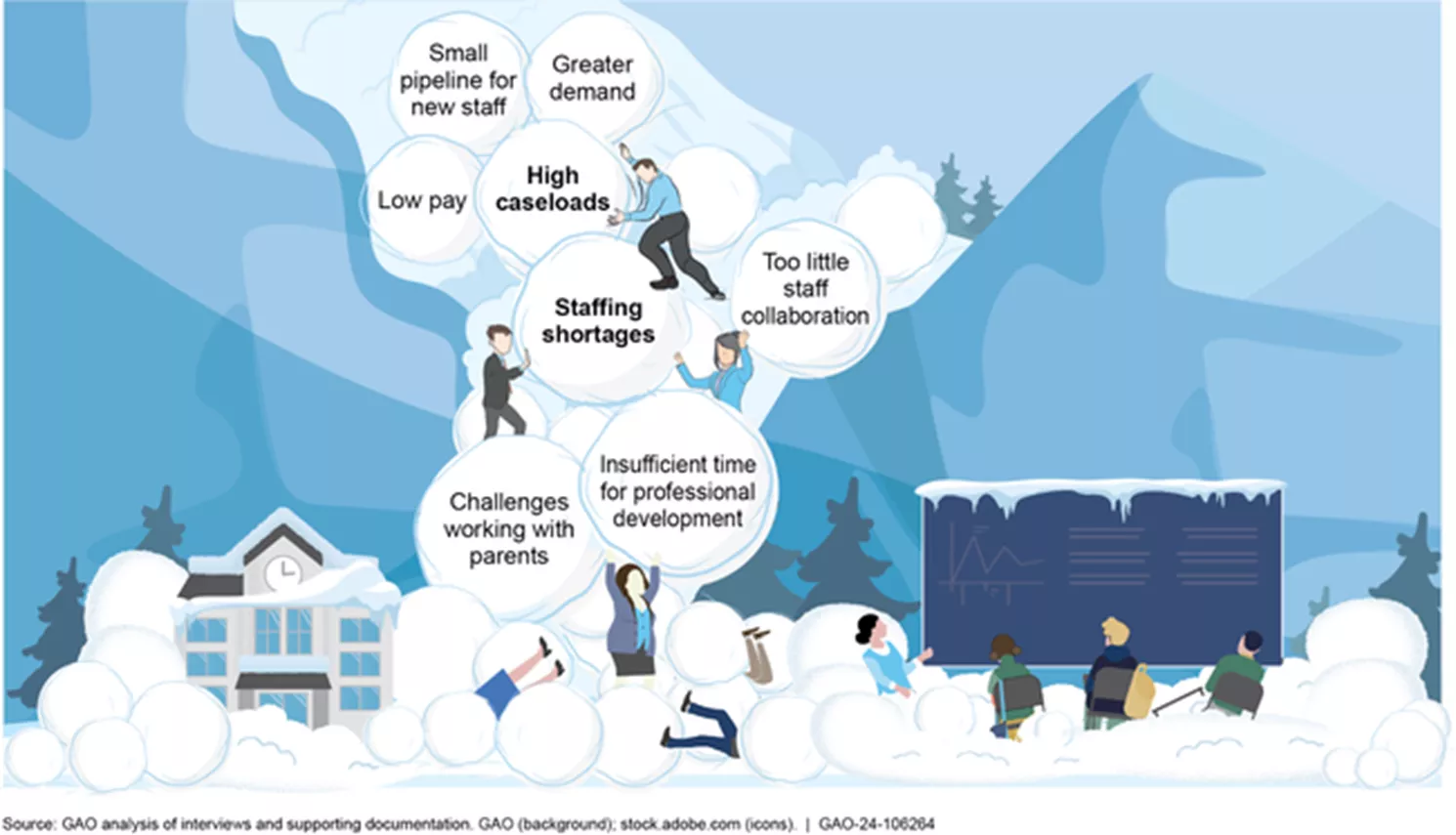K-12 Education
Issue Summary
Federal agencies work to ensure that 50 million preK-12 students have access to a safe, quality education. However, a history of discriminatory practices has contributed to inequities in education, which are intertwined with disparities in wealth, income, housing, and accessibility. Moreover, there are ongoing concerns about the safety and well-being of all students. To help address these issues, the Department of Education (Education), the Department of Health and Human Services (HHS), and the Department of Defense (DOD) should strengthen oversight of key programs, policies, and data collections.
For example:
- School discipline. Education’s data from nearly every U.S. school district found that students' race and ethnicity, gender, and disability status mattered when it came to rates of arrest and referrals to police. For instance, Native Hawaiian/Pacific Islander, Black, and American Indian/Alaska Native students were arrested at rates 2 to 3 times higher than those of White students. For boys in these groups who had a disability, arrest rates were even higher. Yet Education does not collect arrest and referral data by race for all students with disabilities. Additionally, among girls, Black girls faced more and harsher forms of discipline, even for similar infractions.
- Special education. Many children with disabilities are entitled to special education services tailored to their needs through the Individuals with Disabilities Education Act (IDEA.) Yet Education’s data showed that many students with disabilities attend schools without key personnel to support them. For example, in 2021–22, just 20% of public-school students with disabilities attended a school that had a social worker, school psychologist, school nurse, or counselor. This is consistent with research on teacher shortages in general, which show a nationwide shortage of special education teachers. However, Education's ability to understand how and why special education resources are distributed across schools is limited because data on key special education staff are not available at the school level. Additionally, Education does not have authority to collect demographic data on infants and toddlers prior to enrolling for services, which could help meet key goals and purposes of IDEA.
Snowball Effect of Reported Obstacles to Educating Students with Disabilities
Image

- Unwanted sexual behavior among students. DOD’s school system collects detailed information about reported unwanted sexual behaviors—from inappropriate touching to sexual assault—among its more than 66,000 students. However, some students involved in such incidents may not be getting the support they need, such as mental health counseling.
- Head Start. Head Start aims to promote school readiness for young children in poverty. However, Head Start availability varies widely by state and county and doesn't closely align with child poverty. Additionally, almost all Head Start funding is allocated according to a congressionally mandated formula that doesn't account for changes in state population or poverty rates. As a result, Head Start has less flexibility to shift funding to areas most in need.
- School improvement activities. Roughly 2.5 million students attend a K-12 public school that their state has identified as needing "comprehensive support and improvement.” School districts can apply to receive federal funding to help these schools address education inequities and improve student outcomes. States approve school improvement plans and funding requests and monitor these plans to ensure that they are complying with federal requirements. However, Education staff should independently select plans for review to ensure that Education is getting a full picture of these activities.
- COVID-19 challenges. To help address disruptions for K-12 schools nationwide related to the COVID-19 pandemic, school districts received and spent nearly $60 billion in Elementary and Secondary School Emergency Relief (ESSER) funds through school year 2021-22. About 80% of ESSER spending went to addressing students’ academic, social, and emotional needs and continuing school operations. The amount of ESSER funds received by each school district was a key factor in prioritizing spending for selected districts. For some, that meant being able to take care of basic needs while avoiding funding deficits. For others, it meant moving beyond basic needs to making capital improvements or implementing new activities. Not enough time has passed to know if any initial positive effects will remain long-term.
- Dress codes. While nearly all public school districts require students to adhere to dress codes, concerns about equity in school dress codes have included the detrimental effects of removing students from the classroom for dress code violations. Additionally, a nationally representative sample of public school district dress codes revealed school dress codes more frequently restrict items typically worn by girls. And rules about hair and head coverings can disproportionately affect Black students and those of certain religions and cultures.
- School facilities. School districts spend billions of dollars a year (primarily from local government sources) on building and renovating facilities at the nearly 100,000 K-12 public schools nationwide. A survey of school facilities brought up common issues and priorities, such as improving security, expanding technology, and addressing health hazards. Additionally, about half of districts reported needing to update or replace multiple systems like heating, ventilation, and air conditioning (HVAC) or plumbing.
- School shootings. A review of school shooting data found that half were committed by current or former students. Suburban and rural, wealthier, and low-minority schools had more school-targeted shootings; such shootings were the most fatal and most commonly committed by students. Shootings at urban, poor, and high-minority schools were more motivated by disputes; these shootings were often committed by non-students or unknown shooters. While more numerous, these shootings by far had fewer fatalities than school-targeted shootings.

